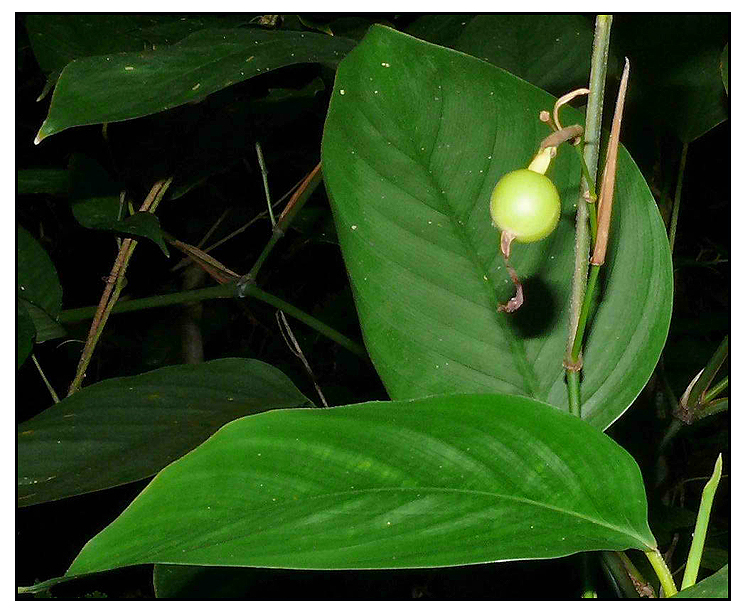|  Gen info Gen info
- Donax is a genus of plants that contains only one recognized species: (12)
Botany
Bamban is a rhizomatous shrub with stems up to
2 to 3 meters tall, several growing in a cluster, smooth, and widely branched.
Leaves are short-petioled, thin, smooth, ovate, 15 to 18 centimeters long and
9 centimeters wide. Petioles are about 1 centimeter long. Panicles are loosely- and few-branched. Calyx tube is about
1 centimeter long, with lanceolate segments which are acute and ribbed. Corolla lobes
are white, linear to oblong, and longer than the tube. Staminodes
are obovate and large, with the tip smaller, obovate and clawed. Anther,
filament and lobe are linear. Fruit is globoid to ellipsoid, slightly
hairy, about 1 centimeter in diameter, and whitish. Seeds are oblong, grooved
and strongly wrinkled.
Distribution
- Very common in secondary forests, especially
along streams, at low and medium altitudes from the Batanes Island and northern Luzon to Palawan and Mindanao, in all or most of the islands and provinces.
- Abundant in the Bicol region, especially Camarines Norte.
- Also occurs in Java and Borneo, to New Guinea, the Aru and Admiralty Islands, New Hebrides, and the Marianne Islands.
 Constituents Constituents
- Phytochemical screening of crude extracts yielded phenolic compounds, alkaloids, tannins, phytosterols, cardiac glycosides, terpenoids, steroids, steroids, saponins, and flavonoids. (see study below) (5)
- Study of methanolic extract from different plant parts of D. grandis for total phenolic content (mg GAE/g plant extract) and antioxidant activity (IC50 mg/ml) were: Fruits 0.65±0.01 and 16.52±0.15, leaves 0.53±0.11 and 16.76±0.53, roots 0.29±0.04 and 14.86±0.06, stems 0.18±0.01 ad 21.85±0.04, respectively. (see study below) (5)
Parts utilized
Roots, stems, leaves.
Uses
Edibility
• In India and Martinique, cultivated for the starch obtained from rhizomes. Rhizomes are edible; sometimes used for making confectionery. (8)
- Used as herb and spice.
Folkloric
• Roots, brewed in decoction,
are used as antidote for snake bites and for blood poisoning.
• Ayta communities from Porac, Pampanga use the plant for the treatment of pasma. (9)
• In Macassar, paste
of young stems with ginger and cinnamon bark is taken for biliousness.
• In Malaysia, the Temuans use the raw fruit orally for boils and abscesses. (4)
• Juice from young curled up leaves used for sore eyes.
• Juice from crushed roots used for fungal infections.
• Infusion of young shoots drunk for treatment of fever.
• Malays use the sap from shoots to treat conjunctivitis.(2) Rhizomes used to treat shingles. Decoction of leaves and roots used as cooling baths for fever. Poultice of leaves and stem used as eye refreshment. (5)
• In Vanuatu, used postpartum to draw placental fragments: right side of the leaf blade is squeezed into a glass of water to drink. (1)
• In Papua, New Guinea, used for ear ache and ear infections. (7)
• In Indonesia, used for abscesses. (11)
• Root decoction drunk to relieve body heat.
Others
- Basketry: Dried split stems are used for basket weaving, making fish
traps and hats, and for sewing nipa shingles. It's importance as weaving material increased as rattans became scarcer. Products are considered generally of lesser quality than those made of rattans. (8)
- Paper making: Pith of stems used for paper making. In New Guinea, leaves are uses as cigarette paper. (8)
Studies
• Antioxidant / Radical Scavenging Activity: Various extracts of leaves, fruits, stems and roots of Donax grandis were evaluated for antioxidant activity. Fruits yielded the highest saponins (2.39 wt%). All parts of plant samples showed high phenolic content (0.18 to 0.65 mg GAE/g). Three solvent fractions showed strong radical scavenging activity from DPPH, ranging from 14.86 to 21.85 mg/mL. Results showed potential use as antioxidant and antiproliferative agent. (see constituents above) (5)
• Anti-Inflammatory: Study evaluated three medicinal plants from North Kalimantan, Indonesia for anti-inflammatory activity using carrageenan-induced paw edema. All three showed potential as source of anti-inflammatory drugs. C. buchananii showed strongest activity. Donax canniformis showed significant (p<0.001) inhibition. (10)
Availability
Wildcrafted.
|



 Constituents
Constituents

